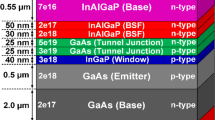Abstract
The silicon vertical multi-junction (VMJ) solar cell has a good potential in high concentration, but it requires high quality front and back surface passivation layers to keep its high efficiency. We try to add dopants into the front and back surfaces of the VMJ cell to release this strict requirement in this work. The effects of recombination velocities, doping types and doping profiles of front and back surfaces on the performance of the P-type VMJ cell were calculated under 1 sun and 1000 suns. The 2D numerical simulation tool TCAD software was used. The performance of the VMJ cell without front and back surface dopants was also calculated for comparison. It was found that the requirement of high quality front and back surface passivation layers could be released remarkably by adding either N-type or P+-type front and back surface dopants. For the two types of front surface dopants, the highest efficiencies of the cells were got by light dopant; for the two types of back surface dopants, the doping type and profile affected little on the performance of the cell in our calculation range. It was also found that the series resistance of the VMJ cell with N-type front surface dopant was decreased by the 2D effect of front surface emitter. The VMJ cell with P+-type front surface dopant had the highest efficiency under 1000 suns and the VMJ cell with N-type front surface dopant had the highest efficiency under 1 sun in our calculation range.
Similar content being viewed by others
References
Gover A and Stella P. Vertical multijunction solar-cell one-dimensional analysis. Electron. Devices, IEEE Trans, 1974, 21(6): 351–356
Rafat N H. A simple analytical treatment of edge-illuminated VMJ silicon solar cells. Sol. Energy, 2006, 80(12): 1588–1599
Xing Y P, Han P D, Fan Y J, et al. Optimization of the emitter region and the metal grid of a concentrator silicon solar cell. J. Semicond, 2013, 34(5): 054005
Sater B L, Sater N D. High voltage silicon VMJ solar cells for up to 1000 suns intensities. IEEE 29th PV Spec Conf. 19–24, May, 2002, 1019-1022
Pozner R, Segev G, Sarfaty R, et al. Vertical junction Si cells for concentrating photovoltaics. Prog. Photovolt: Res. Appl, 2012, 20(2): 197–208
Braun A, Vossier A, Katz E A, et al. Multiple-bandgap vertical-junction architectures for ultra-efficient concentrator solar cells. Energy & Environ. Sci, 2012, 5(9): 8523–8527
Franklin E, Blakers A and Everett V. Sliver solar cells for concentrator PV systems with concentration ratio below 50. Prog. Photovolt: Res. Appl, 2009, 17(6): 403–418
Catchpole K R, Blakers A W and Weber K J. Modelling a monolithically integrated vertical junction cell in low and high injection. Prog. Photovolt: Res. Appl, 2003, 11(2): 113–124
Xing Y P, Han P D, Wang S, et al. Performance analysis of vertical multi-junction solar cell with front surface diffusion for high concentration. Sol. Energy, 2013, 94(0): 8–18
Armstrong G A, Maiti C K. TCAD for Si, SiGe and GaAs integrated circuits. London: The Institution of Engineering and Technology, 2007. 31–40
Aberle A G, Heiser G and Green M A. Two-dimensional numerical optimization study of the rear contact geometry of high-efficiency silicon solar cells. J. Appl. Phys, 1994, 75(10): 5391–5405
Altermatt P. Models for numerical device simulations of crystalline silicon solar cells-a review. J.Comput. Electron, 2011, 10(3): 314–330
Michael S and Bates A. The design and optimization of advanced multijunction solar cells using the Silvaco ATLAS software package. Sol. Energy Mater. Sol. Cells, 2005, 87(1–4): 785–794
Liang Z C, Chen D M, Zhu Y B, et al. Study on the SiN x/Al rear reflectance performance of crystalline silicon solar cells. Sci China Tech Sci, 2010, 53(12): 3209–3213
Liu L, Chen N F, Bai Y M, et al. Quantum efficiency and temperature coefficients of GaInP/GaAs dual-junction solar cell. Sci China Tech Sci, 2009, 52(5): 1176–1180
Hermle M, Granek F, Schultz O, et al. Analyzing the effects of front-surface fields on back-junction silicon solar cells using the charge-collection probability and the reciprocity theorem. J. Appl. Phys, 2008, 103(5): 054507
Granek F, Hermle M, Huljić D M, et al. Enhanced lateral current transport via the front N+ diffused layer of n-type high-efficiency back-junction back-contact silicon solar cells. Prog. Photovolt: Res. Appl, 2009, 17(1): 47–56
Cuevas A and Russell D A. Co-optimisation of the emitter region and the metal grid of silicon solar cells. Prog. Photovolt: Res. Appl, 2000, 8(6): 603–616
Green M A. General solar cell curve factors including the effects of ideality factor, temperature and series resistance. Solid-State Electron, 1977, 20(3): 265–266
Green M A. Solar cells: Operating Principles, Technology and System Applications. Prentice Hall: Englewood Cliffs, 1982. 62–65
Pysch D, Mette A and Glunz S W. A review and comparison of different methods to determine the series resistance of solar cells. Sol. Energy Mater. Sol. Cells, 2007, 91(18): 1698–1706
Altermatt P P, Heiser G, Aberle A G, et al. Spatially resolved analysis and minimization of resistive losses in high-efficiency Si solar cells. Prog. Photovolt: Res. Appl, 1996, 4(6): 399–414
Aberle A G, Wenham S R, Green M A, et al. Decreased emitter sheet resistivity loss in high-eficiency silicon solar cells. Prog. Photovolt: Res. Appl, 1994, 2(1): 3–17
Morales-Acevedo A. Lateral current effects on the voltage distribution in the emitter of solar cells under concentrated sunlight. Sol. Energy, 2009, 83(4): 456–461
Ai B, Zhang Y H, Deng Y J, et al. Study on device simulation and performance optimization of the epitaxial crystalline silicon thin film solar cell. Sci China Tech Sci, 2012, 55(11): 3187–3199
Narasimha S, Rohatgi A and Weeber A W. An optimized rapid aluminum back surface field technique for silicon solar cells. Electron. Devices, IEEE Trans, 1999, 46(7): 1363–1370
Author information
Authors and Affiliations
Corresponding author
Rights and permissions
About this article
Cite this article
Xing, Y., Han, P., Wang, S. et al. Analysis of effects of front and back surface dopants on silicon vertical multi-junction solar cell by 2D numerical simulation. Sci. China Technol. Sci. 56, 2798–2807 (2013). https://doi.org/10.1007/s11431-013-5378-z
Received:
Accepted:
Published:
Issue Date:
DOI: https://doi.org/10.1007/s11431-013-5378-z




